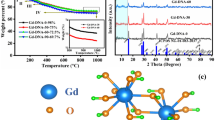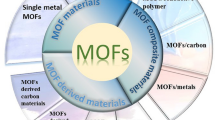Abstract
With remarkable electrochemical stability/conductivity and abundant porous structure, porous carbon electrodes can store considerable amount of charge electrostatically by reversible adsorption of electrolyte, thereby showing high capacity and cycle stability for supercapacitor. However, there was lack of simple and effective ways to synthesize porous carbon materials with controllable structures. Herein, porous carbon materials with controlled structures (copper coin, 3D framework with closed-packing order, and hollow sphere) have been synthesized by an extension of Stöber method using phenolic resin as carbon sources. SiO2 nanoparticles (120 nm) were used as the macroporous templates and Pluronic F127/tetraethyl orthosilicate (TEOS) as mesoporous templates. Adjusting the amount of TEOS helped to explore the synthesis mechanism. As-synthesized porous carbon materials exhibit high surface area of 316–482 m2 g−1 and large pore volumes of 0.306–0.748 cm3 g−1. The materials thereby obtained when used as electrodes in capacitors demonstrate specific capacitance (up to 83 F g−1 at 5 mV s−1) and good robustness after 2000 cycles, which contributed by their abundant porous structure, large surface area/pore volume, morphology, and electrochemical conductivity.










Similar content being viewed by others
References
Alaş MÖ, Güngör A, Genç R, Erdem E (2019) Feeling the power: robust supercapacitors from nanostructured conductive polymers fostered with Mn2+ and carbon dots. Nanoscale 11:12804–12816
Chang TH, Young C, Lee MH, Salunkhe RR, Alshehri SM, Ahamad T, Islam MT, Wu KCW, Hossain MSA, Yamauchi Y, Ho KC (2017) Synthesis of MOF-525 derived nanoporous carbons with different particle sizes for supercapacitor application. Chem Asian J 12:2857–2862
Chang TW, Lin LY, Peng PW, Zhang YX, Hang YY (2018) Enhanced electrocapacitive performance for the supercapacitor with tube-like polyaniline and graphene oxide composites. Electrochim Acta 259:348–354
Dutta S, Kim J, Ide Y, Kim JH, Hossain MSA, Bando Y, Yamauchi Y, Wu KCW (2017) 3D network of cellulose-based energy storage devices and related emerging applications. Mater Horiz 4:522–545
Fenker M, Julin J, Petrikowski K, Richter A (2019) Physical and electrical properties of nitrogen-doped hydrogenated amorphous carbon films. Vacuum 162:8–14
Fu Y, Liu F, Wang H (2020) Spindle Mn2O3/carbon hybrid with homogeneous structure as advanced electrodes for supercapacitors. J Nanopart Res 22:32
Girija TC, Sangaranarayanan MV (2006) Analysis of polyaniline-based nickel electrodes for electrochemical supercapacitors. J Power Sources 156:705–711
Han Y, Dong X, Zhang C, Liu S (2012) Hierarchical porous carbon hollow-spheres as a high performance electrical double-layer capacitor material. J Power Sources 211:92–96
Hao Z, Yang S, Niu J, Fang Z, Liu L, Dong Q, Song S, Zhao Y (2018) Bimetallic oxide Fe1.89Mo4.11O7 electrocatalyst with highly efficient hydrogen evolution reaction activity in alkaline and acidic media. Chem Sci 9:5640–5645
Heimbӧckel R, Kraas S, Hoffmann F, Frӧba M (2018) Increase of porosity by combining semi-carbonization and KOH activation of formaldehyde resins to prepare high surface area carbons for supercapacitor applications. Appl Surf Sci 427:1055–1064
Huang WK, Chung KJ, Liu YM, Ger MD, Pu NW, Youh MJ (2015) Carbon nanomaterials synthesized using a spray pyrolysis method. Vacuum 118:94–99
Ismar E, Karazrhir T, Ates M, Sarac AS (2017) Electrospun carbon nanofiber web electrode: Supercapacitor behavior in various electrolytes. J Appl Polym Sci 135:45723
Jiao Z, Wu Q, Qiu J (2018) Preparation and electrochemical performance of hollow activated carbon fiber-carbon nanotubes three-dimensional self-supported electrode for supercapacitor. Mater Design 154:239–245
Kaneti YV, Dutta S, Hossain MSA, Shiddiky MJA, Tung KL, Shieh FK, Tsung CK, Wu KCW, Yamauchi Y (2017) Strategies for improving the functionality of zeolitic imidazolate frameworks: tailoring nanoarchitectures for functional applications. Adv Mater 29:1700213
Kasap S, Kaya II, Repp S, Erdem E (2019) Superbat: battery-like supercapacitor utilized by graphene foam and zinc oxide (ZnO) electrodes induced by structural defects. Nanoscale Adv 1:2586–2597
Kasuya A, Sasaki Y, Saito Y, Tohji K, Nishina Y (1997) Evidence for size-dependent discrete dispersions in single-wall nanotubes. Phys Rev Lett 78:4434–4437
Li Y, Ding J, Chen J, Xu C, Wei B, Liang J, Wu D (2002) Preparation of ceria nanoparticles supported on carbon nanotubes. Mater Res Bull 37:313–318
Li B, Dai F, Xiao QF, Yang L, Sheng JM, Zhang CM, Cai M (2016a) Nitrogen-doped activated carbon for a high energy hybrid supercapacitor. Energy Environ Sci 9:102–106
Li L, Wang X, Wang S, Cao Z, Wu Z, Wang H, Gao Y, Liu J (2016b) Activated carbon prepared from lignite as supercapacitor electrode materials. Electroanalysis 28:243–248
Li Y, Kim J, Wang J, Liu NL, Bando Y, Alshehri AA, Yamauchi Y, Hou CH, Wu KCW (2018) High performance capacitive deionization using modified ZIF-8-derived, N-doped porous carbon with improved conductivity. Nanoscale 10:14852–14859
Liu WF, Yang YZ, Liu XG, Xu BS (2016) Preparation and electrochemical performance of a polyaniline-carbon microsphere hybrid as a supercapacitor electrode. New Carbon Mater 31:594–599
Liu M, Qin Z, Yang X, Lin Z, Guo T (2019) Fabricating controllable hierarchical pores on smooth carbon sheet for synthesis of supercapacitor materials. Vacuum 168:108806
Meng Y, Gu D, Zhang F, Shi Y, Yang H, Li Z, Yu C, Tu B, Zhao DY (2005) Ordered mesoporous polymers and homologous carbon frameworks: amphiphilic surfactant templating and direct transformation. Angew Chem Int Ed 117:7215–7221
Najib S, Erdem E (2019) Current progress achieved in novel materials for supercapacitor electrodes: mini review. Nanoscale Adv 1:2817–2827
Qian X, Lv Y, Li W, Xia Y, Zhao D (2011) Multiwall carbon nanotube@mesoporous carbon with core-shell configuration: a well-designed composite-structure toward electrochemical capacitor application. J Mater Chem 21:13025–13031
Ryoo R, Joo SH, Jun S (1999) Synthesis of highly ordered carbon molecular sieves via template-mediated structural transformation. J Phys Chem B 103:7743–7746
Salunkhe RR, Hsu SH, Wu KCW, Yamauchi Y (2014) Large-scale synthesis of reduced graphene oxides with uniformly coated polyaniline for supercapacitor applications. ChemSusChem 7:1551–1556
Salunkhe RR, Young C, Tang J, Takei T, Ide Y, Kobayashi N, Yamauchi Y (2016) A high-performance supercapacitor cell based on ZIF-8-derived nanoporous carbon using an organic electrolyte. Chem Commun 52:4764–4767
Schwan J, Ulrich S, Batori V, Ehrhardt H (1996) Raman spectroscopy on amorphous carbon films. J Appl Phys 80:440–447
Stöber W, Fink A, Bohn E (1968) Controlled growth of monodisperse silica spheres in the micron size range. Colloid Interface Sci 26:62–69
Sumboja A, Liu J, Zheng WG, Zong Y, Zhang H, Liu Z (2018) Electrochemical energy storage devices for wearable technology: a rationale for materials selection and cell design. Chem Soc Rev 47:5919–5945
Sun X, Li S, Liu R, Sun X, Liu X, Li A, Li W (2020) A three-dimensional heterogeneous ZnCo-PBA@α-Co(OH)2 nanostructure for high-performance supercapacitors. J Nanopart Res 22:37
Thomsen C, Reich S (2000) Double resonant Raman scattering in graphite. Phys Rev Lett 85:5214–5217
Tuncer M, Bakan F, Gocmez H, Erdem E (2019) Capacitive behaviour of nanocrystalline octacalcium phosphate (OCP) (Ca8H2(PO4)6·5H2O) as an electrode material for supercapacitors: Biosupercap. Nanoscale 11:18375–18381
Veeramani V, Sivakumar M, Chen SM, Madhu R, Alamri HR, Alothman ZA, Hossain MSA, Chen CK, Yamauchi Y, Miyamoto N, Wu KCW (2017) Lignocellulosic biomass-derived, graphene sheetlike porous activated carbon for electrochemical supercapacitor and catechin sensing. RSC Adv 7:45668–45675
Wang Y, Shi Z, Huang Y, Ma Y, Wang C, Chen M, Chen Y (2009) Supercapacitor devices based on graphene materials. J Phys Chem C 113:13103–13107
Wang Z, Liu X, Lv M, Meng J (2010) Simple synthesis of magnetic mesoporous FeNi/carbon composites with a large capacity for the immobilization of biomolecules. Carbon 48:3182–3189
Wang GP, Zhang L, Zhang JJ (2012) A review of electrode materials for electrochemical supercapacitors. Chem Soc Rev 41:797–828
Wang J, Xu Y, Ding B, Chang Z, Zhang X, Yamauchi Y, Wu KCW (2018) Confined self-assembly in two-dimensional interlayer space: monolayered mesoporous carbon nanosheets with in-plane orderly arranged mesopores and high graphitized framework. Angew Chem Int Ed 57:2894–2898
Xu B, Wu F, Chen R, Cao G, Chen S, Zhou Z, Yang Y (2008) Highly mesoporous and high surface area carbon: a high capacitance electrode material for EDLCs with various electrolytes. Electrochem Commun 10:795–797
Xu J, Zheng F, Xi C, Yu Y, Chen L, Yang W, Hu P, Zhen Q, Bashir S (2018) Facile preparation of hierarchical vanadium pentoxide (V2O5)/titanium dioxide (TiO2) heterojunction composite nano-arrays for high performance supercapacitor. J Power Sources 404:47–55
You B, Yang J, Sun Y, Su Q (2011) Easy synthesis of hollow core, bimodal mesoporous shell carbon nanospheres and their application in supercapacitor. Chem Commun 47:12364–12366
Zhai Y, Dou Y, Liu X, Park SS, Ha CS, Zhao D (2011) Soft-template synthesis of ordered mesoporous carbon/nanoparticle nickel composites with a high surface area. Carbon 49:545–555
Zhang S, Chen L, Zhou S, Zhao D, Wu L (2010) Facile synthesis of hierarchically ordered porous carbon via in situ self-assembly of colloidal polymer and silica spheres and its use as a catalyst support. Chem Mater 22:3433–3440
Zhou J, Guo M, Wang L, Ding Y, Zhang Z, Tang Y, Liu C, Luo S (2019) 1T-MoS2 nanosheets confined among TiO2 nanotube arrays for high performance supercapacitor. Chem Eng J 366:163–171
Zou Y, Wang Y, Fang Z, Wu D, Yang S, Hao Z, Lang J, Dong Q (2018) Sulfur powder as a reducing agent to synthesize the Ni@Ni(OH)2 flower-like material for electrochemical capacitors. J Nanosci Nanotechnol 18:7732–7738
Funding
This work was supported by the National Natural Science Foundation of China (21571045), Natural Science Foundation of Heilongjiang Province of China (JJ2020TD0027), Natural Science Foundation of Guizhou Province of China (QKH-J 2020 1Y032), and Ph.D. Start-up Foundation of Zunyi Medical University (Grant F-883) is acknowledged.
Author information
Authors and Affiliations
Corresponding authors
Ethics declarations
Conflict of interest
The authors declare that they have no conflict of interest.
Additional information
Publisher’s note
Springer Nature remains neutral with regard to jurisdictional claims in published maps and institutional affiliations.
Rights and permissions
About this article
Cite this article
Dong, Y., Niu, H., Lin, H. et al. Simple and effective strategy to synthesize porous carbon with controlled structures for supercapacitor. J Nanopart Res 22, 283 (2020). https://doi.org/10.1007/s11051-020-05011-5
Received:
Accepted:
Published:
DOI: https://doi.org/10.1007/s11051-020-05011-5




